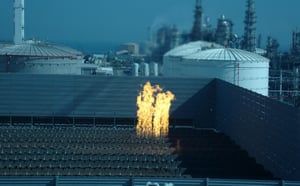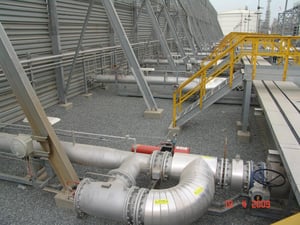Emissions Testing of Sonic Velocity Flares
CATEGORIES:
In a 2012 report by the EPA’s Flare Review Panel, regulations for flares that tended to operate outside their stable flame envelope were expanded to include limits on velocity as a function of net heating value.
EPA regulations do not currently allow sonic velocity flares to be permitted and operated without first performing an alternate means of emissions limitation tests to validate destruction efficiencies. Existing regulations affect the application of multi-point staged flares since these flares operate at sonic exit velocities that exceed the maximum exit velocity requirements cited in 40 CFR 60.18 and 40 CFR 63.11(b) and applicable state regulations.
Over the years, Zeeco has conducted numerous destruction efficiency tests on its multi-point sonic flares. All tests demonstrated high destruction efficiency at velocities exceeding the EPA’s limits. The purpose of these tests, performed at Zeeco’s industrial-scale combustion test facility near Tulsa, Oklahoma, was to validate sonic tips for more applications using an expanded range of gases and conditions. Extractive sampling was used to measure the emissions from the exhaust plume at staging and de-staging pressures. The extracted gas concentrations were used to calculate the destruction efficiency of the multi-point sonic flare tips at each test point. Even with sonic gas exit velocities, the Zeeco-designed sonic flare tips maintained high destruction efficiency.
Despite pressure from both end users and regulators, Zeeco’s flare burner tests and results have been maintained internally. This paper will present those results to the industry.
 Figure 1 – Typical Installation of a MPGF
Figure 1 – Typical Installation of a MPGF
Benefits and Characteristics of Multi-Point Ground Flares
Multi-Point Ground Flares (MPGF) derive their name from their physical layout. Typically, they are a field of multiple pressure-assisted flare tips that are vertically mounted at grade and arranged in stages that open as the upstream pressure (gas flow) increases, and close as pressure decreases. This design concept is the same today as it was when MPGF were invented over 40 years ago. MPGF are often selected to attain smokeless combustion for heavy hydrocarbon service with high available pressure, and have proven to provide stable operation at sonic velocities for a wide range of gas compositions. MPGF are also used in situations when the designer wants to reduce or eliminate radiation or visible flame. The high pressure is used to assist the gas to obtain smokeless operation for the full range of flaring capacity, which can be difficult to do with other assist mediums such as air, gas, or steam due to high smokeless rates. Each burner has unobstructed air access, allowing the momentum from the high exit velocity of the flare gas to entrain the necessary air for combustion. MPGF are designed to provide maximum smokeless performance, while minimizing radiation impacts and plot space. Installing a fence around the field can block the visibility of the flame; this serves a dual purpose by reducing radiation outside the fenced area and reducing the likelihood that flaring operations will be a nuisance to the public. The figure below is an example of a typical MPGF installation.
 Figure 2 – Typical Installation of MPGF Fence
Figure 2 – Typical Installation of MPGF Fence
Another benefit of MPGF is easy access for maintenance because all staging equipment is located at grade and outside of the fence. As a result, personnel can access the staging equipment safely without being affected by a flaring event. Figure 2 illustrates the staging equipment and the exterior of a MPGF fence.
Conclusion
Multi-Point Ground Flares deliver smokeless flaring over a wide range of flows, compositions, and pressures while having minimal impact on surrounding communities. The testing conducted at the Zeeco Combustion and Research Test Facility investigated the effect of NHV and exit velocity on the stability and efficiency of Zeeco’s pressure-assisted flare tips. All test results with stable flames demonstrate Zeeco’s pressure-assisted flare tips provide high destruction and removal efficiency even at high exit velocities exceeding current regulatory limits. The extractive sampling results validated the performance of the new FlareSentry, which is pioneering a practical method of monitoring and measuring flare efficiency. This testing has reinforced the industry consensus that pressure-assisted flare tips are capable of providing smokeless flaring with high destruction and removal and combustion efficiencies over a wide range of gas compositions and pressures. Recommendations for future testing are to investigate the stability of lower NHVs over a range of pressures and exit velocities as well as the effect of different ratios of combustible to inert gases. Current and future regulations should consider all available test results and allow the use of pressure-assisted flares with high exit velocities, up to and including Mach 1.0, without the need to perform an AMEL.
Download Technical Paper